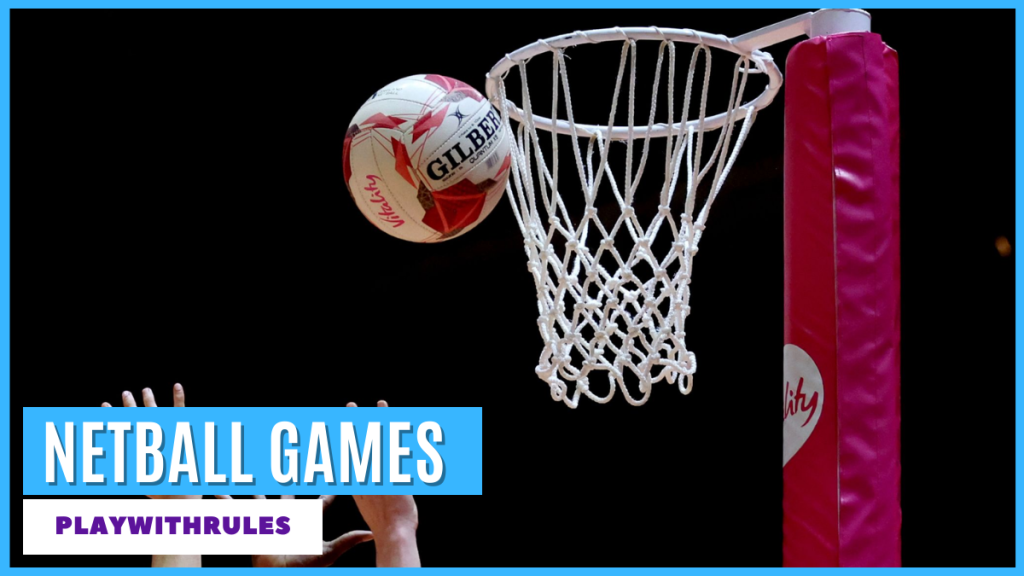Sports fans! Have you ever heard of a Netball Game? If not, buckle up and get ready to enter the world of a sport in which you need to coordinate with your teammates, pass, jump, block, shoot, and score—all while ensuring you follow the Netball rules. The game is played on a court similar to that of Basketball. In fact, quite a few aspects of this game have been a derivation of the game. However, Netball has its own rules, and the gameplay is truly unique.
Today, we will learn everything there is to learn about this game – the rules, how to score and win, and a couple of fascinating Netball facts that you can share with your friends as you explain the game to them. Ready to learn a new game? Then let’s get into it!
Table of Contents
How To Play Netball?
Two teams compete in this game on a court bigger than a basketball court. Each team tries to have possession of the ball and score more points/goals before the clock runs out. To score, each team has to pass the ball amongst the players to create opportunities while simultaneously defending its own goals.
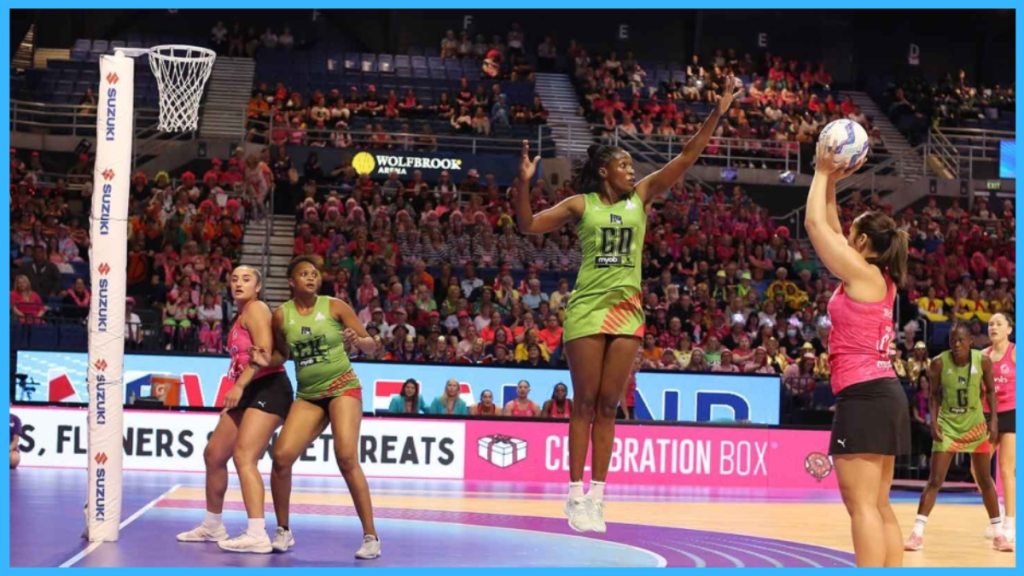
Objective
The objective of each team is to score more goals than the other before the clock runs out while also defending their own goal to reduce the chances of their opponent scoring. Now that you know what you need to do in Netball, let’s figure out what you can and cannot do.
Netball Rules
Just like any other sport, Netball has its own set of rules, and mind you—they are quite stringent. In this section of the article, we will discuss the different facets of the game and the regulations associated with them.
1. General Rules Of Netball
Before diving into the thick of it, let’s talk about the general Netball rules. They are as follows:
- Each team consists of 7 players (only 7 players from each team can play on the court at any point).
- A standard Netball game consists of four quarters, each 15 minutes long, for a total playtime of 60 minutes. However, added time is awarded for injuries.
- After a goal, the game resumes with a centre (a centre pass to restart the game).
- After every quarter, the game restarts with a centre pass. In this case, the team restart with the center pass alternates.
- Every goal adds 1 point to the respective teams’ scoreboard.
- Not all players can shoot and score goals. Only the Goal Attack (GA) and the Goal Shooter (GS) can shoot.
- To shoot a goal, the GA or the GS need to be in the opponent’s goal circle (explained later).
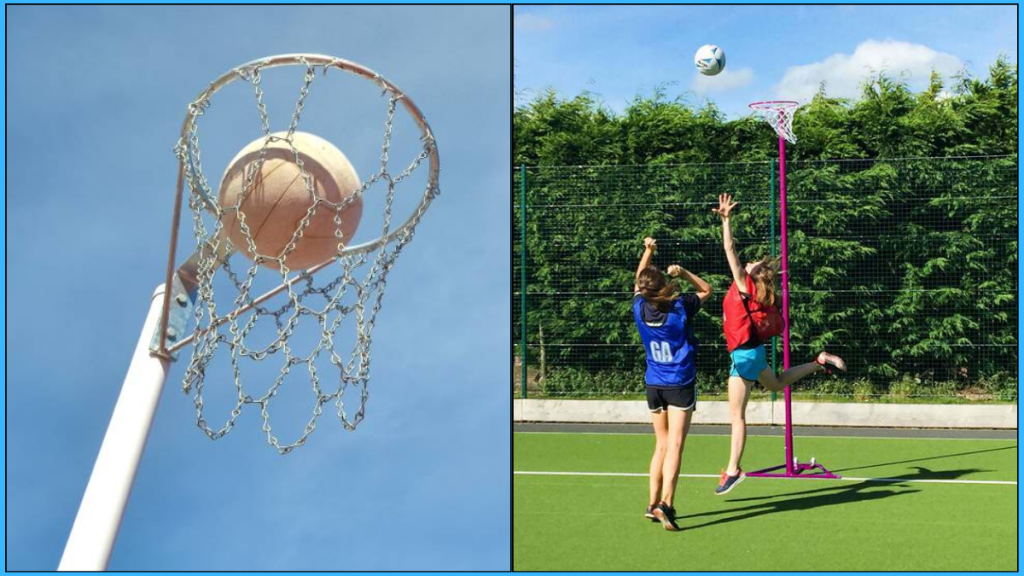
2. Movement, Possession, Passing, & Shooting
There are Netball rules governing how players can move with the ball and without it, which passes are allowed, and what constitutes a legal shot at goal. Let’s find out:
- Players are allowed to keep possession of the ball for a maximum of 3 seconds. They either have to pass the ball or make a shot within that time. Failing to do so will result in the opponent being awarded possession of the ball.
- When passing to another player, you must ensure that the distance of the pass is at least 3 feet. Otherwise, it could result in a ‘short pass’ and the opponent gaining possession of the ball.
- In addition to the rule above, you cannot make a massively long pass, either. A pass cannot be made across two consecutive transverse lines on the court. This will also result in infringement, and the opponent will get the ball.
- In netball, players’ movement is restricted. Once a player catches a ball or receives a pass, the foot that they land on is called the landing foot. They cannot lift this foot off the ground after they have received the pass or caught the ball.
- The landing foot can be used as leverage, and players can rotate in any direction to make a pass or shoot (all while not lifting the landing foot).
- Lifting the landing foot will result in a ‘foul,’ and the opponent will get the ball.
- One thing to remember here is that only the GA and the GS can shoot the ball into the opponent’s net. However, they must be within the opponent’s goal circle.
3. Defending, Blocking, & Intercepting
Rigid regulations exist in the game’s defending and attacking aspects to ensure fair gameplay. The rules of Netball for defending, blocking, and intercepting are as follows:
- A defending player cannot touch or make any physical contact during the game. This will result in a ‘foul.’
- Players are allowed to intercept passes and block shots.
- When blocking a shot at a goal or a pass, a defending player must maintain a 3 ft distance from the shooting player. Otherwise, it is called ‘obstruction,’ and a foul will be declared. Then, the opponent will get the ball.
- Players can jump and run within their designated areas (explained later in the article to intercept passes).
4. Footwork
Footwork plays a crucial role in Netball, and while the definition might refer to general footwork in a game, in Netball, it stands for something more. As mentioned earlier, when catching a ball, if a player lands on a single foot, it is called the landing foot. The Netball rules for footwork are as follows:
- The player can step with the other foot with the landing foot in the air and pass or shoot the ball. However, they must ensure they throw the ball before the landing foot touches the ground again.
- The player can pivot and change directions by stepping with the other foot (not the landing foot) as often and in any direction they want. They cannot step, hop, or lift the landing foot until they throw the ball.
- The player can jump and switch the landing foot. However, they have to jump again to throw the ball.
- If a player lands on both feet when catching the ball, the player decides which foot to use as their landing foot.
- A violation of the footwork rule results in a foul, and the opposing team is awarded a free pass.
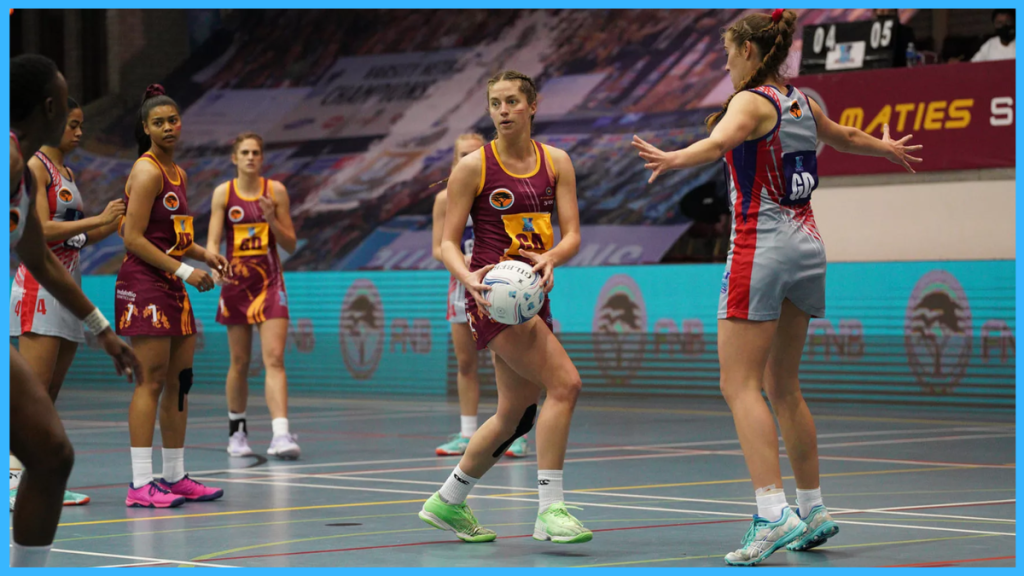
Netball Positions
To understand the Netball Game and to truly appreciate it, you must understand the importance of positioning. That is where this game gets enjoyable. Here are the different Netball positions and the roles associated with those positions:
Positions:
- Goal Keeper (GK)
- Goal Defence (GD)
- Wing Defence (WD)
- Centre (C)
- Wing Attack (WA)
- Goal Attack (GA)
- Goal Shooter (GS)
Each position mentioned above has dedicated roles and areas of play across the court. Let us explain:
- The GK can only move within the goal third that they are defending (their own team’s half).
- The GD can only move within their goal third and the middle third (own team’s half and centre).
- The WD can move within their goal third and the middle third but not within their own goal circle.
- The Centre (C) can move in and out of all thirds (their own, the middle, and the opponent’s) but cannot enter any of the goal circles (their own or the opponent’s).
- The WA can move in the middle third and the opponent’s third (the opponent’s half of the court). However, they cannot enter the opponent’s goal circle.
- The GA can move in the middle third, the opponent’s goal third, and the opponent’s goal circle (this is because they can score goals).
- The GS can move only within the opponent’s goal third and their goal circle.
Major & Minor Infringements (Fouls)
Now that we know how to play Netball, let’s learn about the major and minor fouls in this game. Infringements are fouls that can lead to a change in possession. Some infringements are considered minor, while others are considered major. Let’s find out what these infringements are:
Major Infringements
- Making physical contact with an opponent player on the court or touching them counts as a major infringement.
- Failing to maintain a 3 ft distance with the opposing player when the opponent is passing or shooting. Players can only block or intercept once the ball is in the air. They cannot knock it out of the opponent’s hand.
- Marking other players is allowed. However, any physical contact with the opponent player will result in a penalty pass awarded to that player or that team.
- If contact is made involuntarily or mistakenly, a penalty pass will still be awarded if it unfairly hinders the attacking player.
Minor Infringements
- A player cannot run with or dribble the ball like in Basketball.
- After receiving a pass, a player can bat the ball or bounce the ball only once. They cannot do both and can do either of the two (bat or bounce) only once before passing or shooting.
- Players cannot push or throw the ball into the air before bouncing or batting it.
- A player needs to be stationary or standing still to pass the ball.
- Players cannot take more than 3 seconds to pass the ball.
- Players on the same team need to make room between themselves to allow opponents to try to intercept the ball. A valid pass must be over a distance of at least 3 feet.
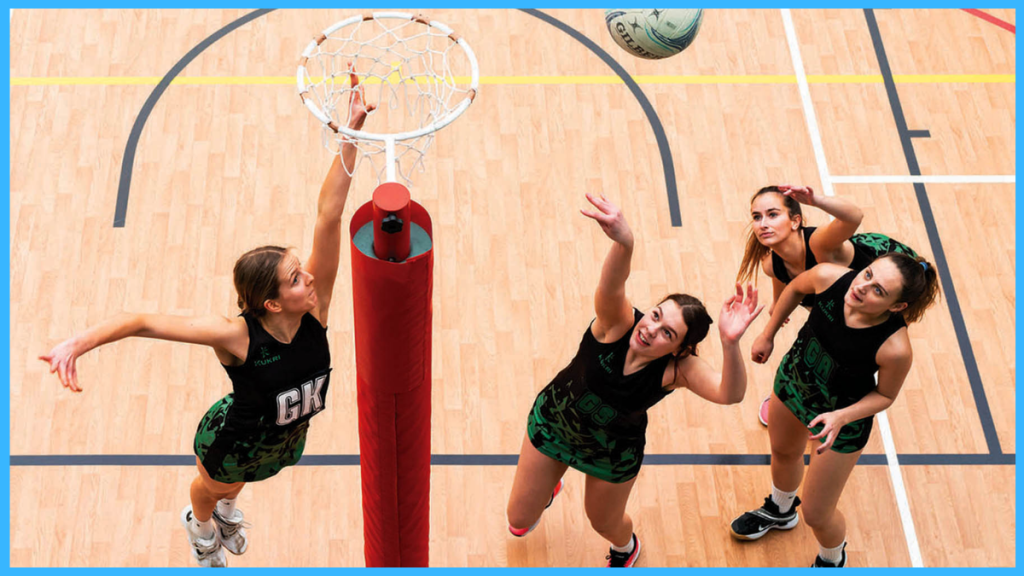
Important Terms
Now that you have been introduced to the Netball rules, so let’s discuss some important terms and what they mean. For example:
Free Pass Or Shoot
In the case of a minor infringement, the team that was hindered or was fouled is awarded a free pass. Mentioned below are some infringements that can lead to a free pass:
- Kicking the ball
- Footwork
- Footwork inside the centre circle
- Offside
- Stepping onto the court during a throw-in
- Over a third
- Player not catching the ball in the centre third after a centre throw
- The centre player is not in the centre at the start of a play
- Delaying the game
In case of a major infringement, the fouled team is also awarded a free pass or a ‘shoot.’ This includes physical contact, obstruction, blocking within 3 feet, etc.
Throw In
When the ball leaves the playing area of the court by crossing one of the sidelines, a ‘Throw-In’ is awarded to the team, none of whose players touched the ball last before it went out. In simpler terms, the opposing team of the player touches the ball before the ball crosses the playing boundary of the court and gets the throw-in. They can then pass the ball to any player from the sideline.
50/50
There might be situations during a game where two players from opposing teams foul each other. In such a situation, if the referee is unable to decide who to award a free pass or shot to (fairly), then a 50/50 is called. By this rule, both the offending players (or two of the closest players from opposing teams) are given a chance to win the ball. The 50/50 is also given if two players from opposing teams catch the ball simultaneously.
Toss Up
The toss-up is an extension of the 50/50 play. In this, the two offending players (or the two nearest players) are called. They are to stand facing each other while maintaining a 3 ft distance between them. The referee then tosses the ball in the middle, and once the ball is in the air, it is up for grabs.
Offside
Offside is called if a player moves into a position or a part of the court that they are not supposed to be in. In this case, the ball is awarded to the other team.
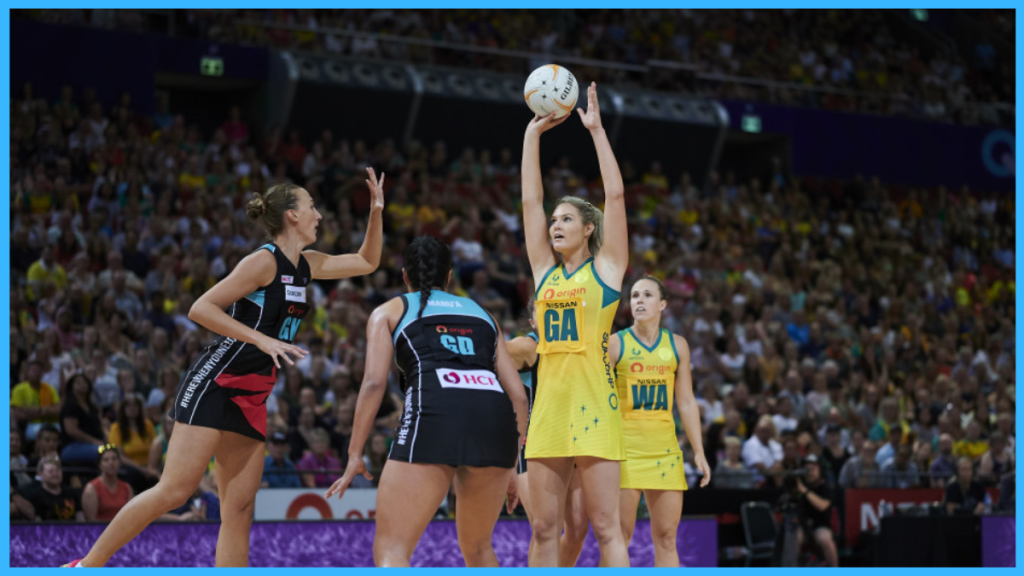
Scoring
To score, the GA (Goal Attack) or the GS (Goal Shooter) needs to get inside the opponent’s goal circle and shoot the ball into the hoop. However, they must be inside the goal circle to do this. Each goal or each successful hoop counts as 1 point.
Winning
The way to win in a Netball game is no different from that of Basketball or Soccer. Every team should aim to use a combination of defensive and offensive strategies to secure a win over the opposing team. To win, a team must have at least a one-goal lead over the other team when time runs out. The team with the most goals/hoops at the end of the game wins.
Court & Players
In this section of the article, we will discuss the court – its dimensions, the height of the goal hoop, etc.- and the number of players each team can have and their different positions.
Court:
- The court is 100 ft (L) X 50 ft (W).
- The goal hoop is 10 ft above the ground.
- The shooting circles aim to have a radius of 16 ft.
- The centre circle is 3 ft in diameter.
Players:
Each team can have 7 players on the court. The different play positions are Goal Keeper, Goal Defence, Wing Defence, Centre, Wing Attack, Goal Attack, and Goal Shooter (1 player per position). However, games can continue with 5 players on a team as well.
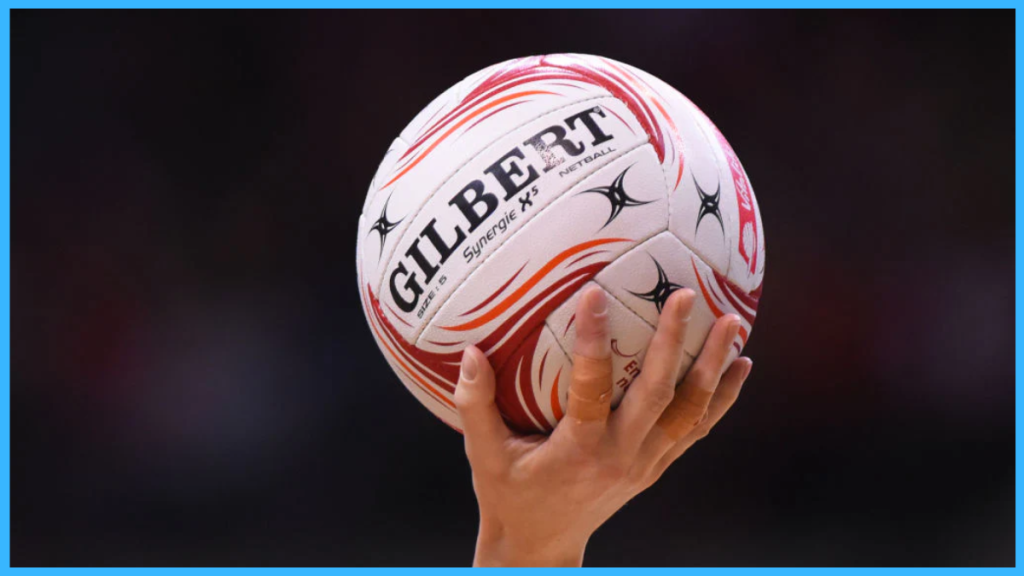
Did You Know?
- Netball game originated in England in 1890. It was derived from an early version of Basketball.
- The International Federation of Netball Associations is the official governing body of the game. They have over 60 teams playing across the globe.
- The first set of rules of netball was established back in the 1960s.
- However, netball has gained the most popularity in Commonwealth countries such as Australia, South Africa, Jamaica, New Zealand, etc.
- The Netball World Cup is held every four years.
FAQs
What is the difference between Netball and Basketball?
While Netball game was actually derived from an older version of Basketball, the modern-day versions of both games are poles apart. Netball rules regulate footwork, throwing, etc. that are not part of the Basketball handbook. Plus, the size of the court also varies; the netball court is bigger than the basketball court.
Can men play Netball?
Yes, of course they can! Although the game is played predominantly by women, there are men’s and mixed-gender teams.
How many players are needed to play a Netball game?
To play Netball, each team needs to have 7 players.
Can you dribble in Netball?
No. You cannot dribble in Netball.
How is netball different from basketball?
Netball is played on a court with seven players per team, each with specific positions and zones. The ball must be passed within three seconds, and players can’t dribble or run with the ball. The goalposts have no backboards, and only certain players can shoot.
What is not allowed in netball?
In netball, players cannot run with the ball, dribble, or hold the ball for more than three seconds. Contact is limited, and players must stay within their designated zones. Stepping on the shooting circle line is also not allowed.
How do you explain netball to beginners?
Netball is a fast-paced team sport played with seven players per team. The goal is to pass the ball within three seconds and shoot it into a goalpost without a backboard. Players have specific positions and zones, and contact is limited.
Netball game is quickly becoming a popular sport globally due to its emphasis on teamwork, strategy, and positioning. In fact, some bodies advocate including Netball in the Olympics. This dynamic sport sounds a bit complicated, but the game is so much fun once you are in the thick of it. So, what are you waiting for, enjoy the game while following the netball rules. To stay updated with all types of sports, indoor, and fun card games, keep coming back to Play With Rules.

